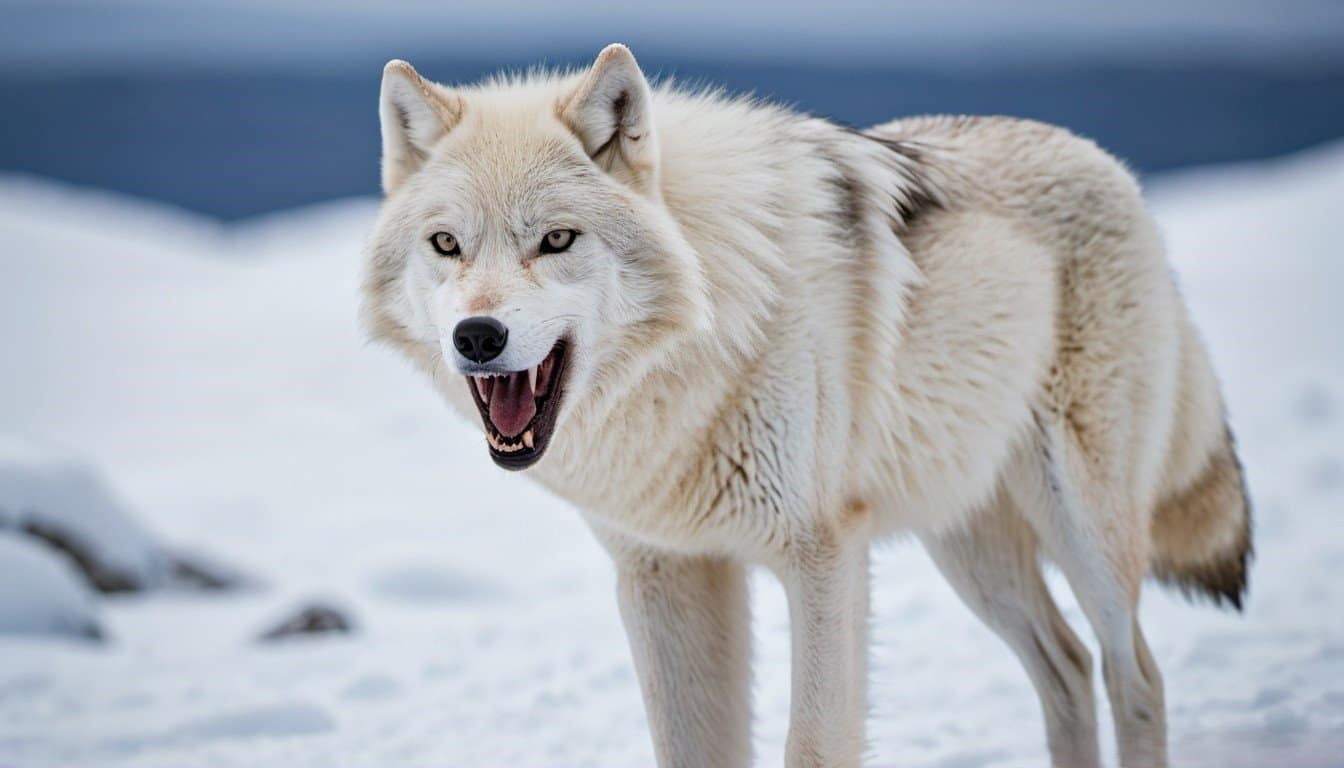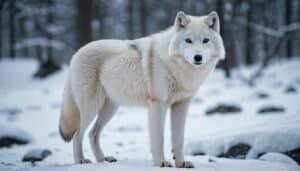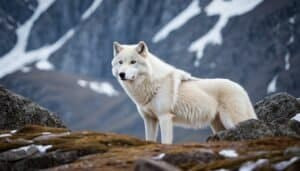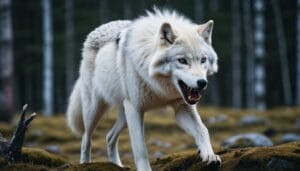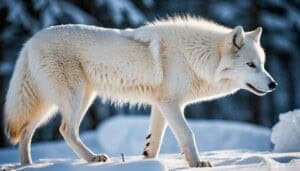Introduction
The Arctic wolf’s jaw structure plays a critical role in its hunting habits, enabling it to thrive in the harsh Arctic environment
This article delves into the key features and anatomy of the Arctic wolf’s jaw, its teeth and their role in hunting efficiency, comparisons with other wolf species, prey and hunting strategies, adaptations for cold environments, and evolutionary perspectives on its jaw structure
Understanding these aspects provides insight into how the Arctic wolf has adapted to become a proficient hunter in one of the most challenging habitats on Earth
Key Features and Anatomy of the Arctic Wolf’s Jaw
The Arctic wolf’s jaw is a fascinating example of evolutionary adaptation that supports its survival and hunting efficiency in the harsh Arctic environment. This section explores the anatomy of the Arctic wolf’s jaw and the muscle strength and bite force that enable it to hunt effectively
Anatomy of the Jaw
The Arctic wolf’s jaw structure is robust and powerful, designed to endure the demands of hunting and consuming prey in a challenging habitat. Key anatomical features include:
Skull Structure: The Arctic wolf’s skull is broad and sturdy, providing a strong foundation for its powerful jaw muscles. This structure is essential for generating the force needed to capture and kill prey
Mandible: The lower jaw, or mandible, is particularly strong and well-developed. This feature allows the wolf to exert significant pressure when biting, crucial for penetrating the thick hides of some Arctic prey
Temporomandibular Joint (TMJ): The TMJ connects the mandible to the skull and allows for the movement necessary to open and close the jaw. In Arctic wolves, this joint is highly flexible and robust, enabling a wide gape and powerful bite
Muscle Strength and Bite Force
The muscle strength and bite force of the Arctic wolf are key to its hunting success. These wolves rely on their jaws not just for killing prey but also for processing food in a way that maximizes their caloric intake from each catch:
Muscle Anatomy: The primary muscles involved in the Arctic wolf’s biting mechanism are the temporalis and masseter muscles. These muscles are exceptionally well-developed in Arctic wolves, providing the force needed for their powerful bite
Bite Force: Arctic wolves have one of the strongest bite forces among canids. Their bite force is estimated to be around 1,500 pounds per square inch (PSI), enabling them to crush bones and tear through flesh efficiently
This capability is vital for accessing the nutrient-rich marrow inside bones, especially important in the nutrient-scarce Arctic environment
Adaptability: The strength of an Arctic wolf’s bite also allows it to tackle a variety of prey, from small mammals to larger herbivores. This adaptability is crucial for survival, as the availability of prey can vary greatly with the seasons and harsh weather conditions
The anatomical and muscular features of the Arctic wolf’s jaw are perfectly adapted to its hunting needs. By understanding these key features, we gain insight into how these formidable predators thrive in one of the planet’s most extreme environments
Teeth and Hunting Efficiency
The teeth of the Arctic wolf play a pivotal role in its hunting efficiency and overall survival. Designed for gripping, tearing, and consuming prey, these teeth are key to the wolf’s predatory success in the challenging Arctic environment
Types of Teeth
Arctic wolves have a specialized set of teeth that serve various functions essential for hunting and consuming their prey. These teeth include:
Incisors: Located at the front of the mouth, incisors are small and pointed, ideal for nipping and pulling at the flesh of prey. They help the wolf to delicately remove meat from bones and other parts of the carcass
Canines: The canines are the most prominent teeth in an Arctic wolf’s mouth. Long, sharp, and powerful, these teeth are designed for gripping and puncturing. They play a crucial role in the initial capture and killing of prey, allowing the wolf to latch onto and immobilize its target effectively
Premolars and Molars: These teeth are located towards the back of the mouth and are used for shearing and grinding meat and bones. The carnassial teeth, a type of premolar, are particularly significant as they act like scissors, slicing through flesh and crushing bones to extract maximum nutrients
Aid in Prey Capture and Consumption
The design and arrangement of the Arctic wolf’s teeth significantly enhance its ability to capture and consume prey. Here’s how each type of tooth contributes to these processes:
Gripping and Holding Prey: The canines are instrumental in this aspect. When an Arctic wolf captures prey, it uses its canines to deliver a powerful, penetrating bite, often to the throat or neck, to subdue the animal quickly and effectively
Tearing Flesh: Once the prey is immobilized, the wolf uses its incisors and canines to tear through the flesh. This tearing action is essential for breaking down the prey into manageable pieces that can be swallowed or further processed by the molars
Bone Crushing: The premolars and molars come into play after the initial capture and consumption of softer tissues. These teeth are strong enough to crush bones, allowing the wolf to access marrow and other vital nutrients
This capability is particularly important in the Arctic, where every bit of nutrition must be utilized due to the scarcity of food resources
Maximizing Nutrient Intake: By utilizing all parts of the prey, from flesh to bone marrow, Arctic wolves ensure they get the maximum possible nutritional benefit from each kill. This efficiency is crucial for survival in an environment where food can be scarce and the energy demands are high due to the cold climate
The teeth of the Arctic wolf are a perfect example of evolutionary adaptation, each type serving a specific function that contributes to the wolf’s overall hunting efficiency. Understanding these roles helps us appreciate how Arctic wolves thrive in their environment by optimizing their physical capabilities to meet the demands of their predatory lifestyle
Comparison with Other Wolves
Comparing the Arctic wolf with other wolf species provides insights into the unique adaptations that make the Arctic wolf a proficient hunter in its environment. This section explores the differences in jaw structure and bite force between the Arctic wolf and other wolf species
Differences in Jaw Structure
The jaw structure of the Arctic wolf differs from that of other wolf species in several notable ways:
Robustness: The Arctic wolf’s jaw is more robust compared to other species like the gray wolf. This robustness is an adaptation to the harsh Arctic environment, where the wolf often needs to tackle large, strong prey and crush bones to access marrow
Shape and Size: Arctic wolves typically have broader and more powerful jaws, which are necessary for generating the significant bite force required to subdue larger prey and break through thick bones
This is in contrast to some other wolf species that may have narrower jaws adapted to a diet consisting of smaller or softer prey
Dentition: While the overall dental formula is similar across wolf species, the Arctic wolf’s teeth, particularly the canines and carnassials, are often larger and more pronounced. This adaptation aids in gripping and tearing flesh from larger prey that are common in their environment
Bite Force Comparison
The bite force of the Arctic wolf is another critical factor that sets it apart from other wolf species. Here are the key points of comparison:
Arctic Wolf: With an estimated bite force of around 1,500 pounds per square inch (PSI), the Arctic wolf has one of the strongest bites among canids
This powerful bite is essential for crushing the bones of larger prey and accessing the nutrient-rich marrow inside
Gray Wolf: The gray wolf, which is the most widely known wolf species, has a bite force that is generally lower than that of the Arctic wolf, averaging around 1,200 PSI
While still strong, this bite force is more suited to a diet that includes a mix of large and small prey, often in less extreme environments
Other Wolf Species: Wolves like the red wolf and the Ethiopian wolf, which inhabit different environments and have different dietary needs, tend to have even lower bite forces
Their jaws and teeth are adapted more for hunting smaller prey and scavenging, rather than taking down large herbivores and breaking bones
These differences in jaw structure and bite force highlight the Arctic wolf’s specialization for survival in a harsh and unforgiving environment. The robust jaw and powerful bite force enable the Arctic wolf to efficiently hunt and consume large prey, which is a critical advantage in the nutrient-scarce Arctic
Prey and Hunting Strategies
The Arctic wolf’s jaw structure and teeth play a critical role in its hunting strategies and ability to secure prey in its harsh environment. This section delves into the common prey of the Arctic wolf and the specific role its jaw plays in capturing and killing prey
Common Prey
The Arctic wolf has adapted to hunt a variety of prey that can survive in the extreme Arctic conditions. The availability of prey influences the wolf’s hunting strategies and jaw adaptations. Common prey includes:
Muskoxen: One of the largest and most formidable prey, muskoxen require significant strength and coordination to hunt. Arctic wolves often target young, old, or weakened individuals to increase their chances of success
Caribou: Another primary prey species, caribou are migratory and provide a significant food source for Arctic wolves. Hunting caribou requires stamina and teamwork, as these animals can run at high speeds for long distances
Arctic Hares: Smaller and more agile, Arctic hares are another common prey. These hunts rely more on speed and stealth than brute strength, requiring the wolf to use its teeth and jaw for quick, precise kills
Lemmings and Rodents: In times of food scarcity, Arctic wolves will hunt smaller prey like lemmings and other rodents. These small mammals provide essential sustenance, particularly during lean times
Jaw’s Role in Capturing and Killing Prey
The Arctic wolf’s jaw is instrumental in capturing and efficiently killing its prey. The following points illustrate how the jaw and teeth function in various hunting scenarios:
Initial Capture: The powerful canines are crucial during the initial capture of prey. The Arctic wolf uses its canines to grip and hold onto its prey, often targeting the neck or throat to quickly immobilize the animal
This grip is strong enough to prevent the prey from escaping and to start the process of subduing it
Killing Bite: Once the prey is immobilized, the Arctic wolf delivers a killing bite. For larger prey like muskoxen or caribou, this bite is usually directed at the throat, cutting off the airway and causing a quick death. The strength of the wolf’s jaw ensures that the bite is deep and effective
Consuming Prey: After the prey is killed, the wolf’s teeth and jaw continue to play a critical role. The incisors and canines tear the flesh into manageable pieces, while the premolars and molars crush bones and shear through tougher tissues
This process maximizes the nutritional intake from each kill, ensuring that the wolf gets the necessary energy to survive in its demanding environment
Teamwork in Hunting: Arctic wolves often hunt in packs, particularly when targeting large prey. The cooperation of pack members allows for more efficient hunting and ensures that each wolf can access enough food
The strong jaws of multiple wolves can bring down prey more quickly and divide the labor of consuming the carcass
The Arctic wolf’s hunting strategies are a direct reflection of its jaw’s capabilities. The combination of powerful bite force, specialized teeth, and strong jaw muscles allows the Arctic wolf to effectively capture, kill, and consume a variety of prey, ensuring its survival in the harsh Arctic landscape
Adaptations for Cold Environments
The Arctic wolf is a master of survival, perfectly adapted to thrive in one of the planet’s harshest climates. Its jaw structure, along with various physical and behavioral adaptations, enables it to hunt effectively and sustain itself in the frigid Arctic environment
Physical Adaptations
Physical adaptations are crucial for the Arctic wolf’s survival, allowing it to withstand extreme cold and navigate the challenging terrain:
Thick Fur: The Arctic wolf has a dense, multi-layered coat that insulates it against sub-zero temperatures. The outer layer of fur is water-repellent, while the dense undercoat provides insulation, helping to conserve body heat
Paws: The wolf’s paws are wide and covered with fur, which helps distribute its weight on snow and ice, preventing it from sinking. This adaptation is essential for hunting, as it allows the wolf to move swiftly and silently across its snowy habitat
Compact Size: Compared to other wolf species, Arctic wolves are generally smaller and more compact, which reduces the surface area exposed to the cold and helps retain body heat
Nasal Passages: The nasal passages of Arctic wolves are adapted to warm the air before it reaches the lungs, preventing cold air from reducing their core body temperature. This adaptation is vital for maintaining body heat during long hunts
Behavioral Adaptations
Behavioral adaptations are equally important for the Arctic wolf, influencing how it hunts, conserves energy, and survives in its environment:
Hunting in Packs: Arctic wolves often hunt in packs, which increases their success rate when targeting large prey such as muskoxen and caribou. Pack hunting allows them to use cooperative strategies to encircle and take down prey that would be difficult for a single wolf to manage
Seasonal Migration: Following the migrations of prey animals like caribou ensures a steady food supply. Arctic wolves are highly nomadic, covering vast distances to find food, which helps them survive when prey is scarce in one area
Caching Food: During times of abundance, Arctic wolves will cache excess food by burying it in the snow. This behavior ensures they have a food reserve during lean periods when hunting is less successful
Energy Conservation: Arctic wolves are adept at conserving energy. They rest frequently and move at a steady, sustainable pace to avoid unnecessary energy expenditure. This behavior is crucial for survival in an environment where the energy cost of maintaining body heat and finding food is high
These physical and behavioral adaptations, combined with the Arctic wolf’s specialized jaw structure, enable it to hunt efficiently and survive in one of the most extreme environments on Earth. By optimizing its physical attributes and behaviors, the Arctic wolf exemplifies the remarkable adaptability of wildlife in the Arctic
Evolutionary Perspectives
The evolutionary journey of the Arctic wolf provides fascinating insights into how its jaw structure and overall anatomy have adapted over time to suit its environment. This section explores the evolution of the Arctic wolf’s jaw structure and the impact of its diet on its evolutionary path
Evolution of Jaw Structure
The Arctic wolf’s jaw structure is a product of millions of years of evolution, shaped by environmental pressures and the need for survival:
Natural Selection: Over generations, Arctic wolves with stronger, more robust jaws had a survival advantage. These wolves were better able to capture and consume the large, tough prey available in their environment
Consequently, they were more likely to survive and reproduce, passing on these beneficial traits to their offspring
Adaptation to Prey: The primary prey of Arctic wolves, such as muskoxen and caribou, are large and often require significant bite force to subdue
The evolution of a powerful jaw structure equipped the Arctic wolf with the tools needed to tackle such formidable prey. This adaptation is evident in the development of strong canines and carnassials that can puncture and shear through tough hides and bones
Environmental Pressures: The extreme cold and scarcity of food in the Arctic exerted pressure on the Arctic wolf population to develop efficient hunting tools
The robust jaw and powerful bite force are direct responses to these environmental challenges, ensuring that the wolves can maximize their nutritional intake from each kill
Impact of Diet on Evolution
The Arctic wolf’s diet has played a significant role in shaping its evolutionary path, particularly its jaw structure and dentition:
Nutrient-Rich Diet: The Arctic wolf’s diet is rich in protein and fat, derived from the flesh and bones of large prey. This nutrient-rich diet necessitated the evolution of a jaw capable of processing such food
The ability to crush bones and access marrow provided a critical source of energy and nutrients, especially during the harsh winter months
Bone-Crushing Capability: The diet of the Arctic wolf often includes bones, which are a valuable source of calcium and other minerals. Over time, the need to crush and consume bones led to the development of stronger jaws and specialized teeth that can handle this task
This bone-crushing capability is a distinctive feature of the Arctic wolf, setting it apart from other wolf species with less demanding dietary requirements
Scavenging and Hunting: The Arctic wolf’s opportunistic feeding behavior, including both hunting and scavenging, influenced its evolutionary development
Wolves that could efficiently hunt large prey and scavenge remains with their powerful jaws had a higher survival rate. This dual feeding strategy ensured a consistent food supply, further reinforcing the traits that supported these behaviors
The evolutionary adaptations of the Arctic wolf, particularly its jaw structure, highlight the intricate relationship between environmental pressures, dietary needs, and natural selection. By understanding these evolutionary perspectives, we gain a deeper appreciation of how the Arctic wolf has become a formidable predator, perfectly suited to its challenging habitat
Conclusion
The Arctic wolf’s jaw structure is a testament to the remarkable adaptations that enable this predator to thrive in the extreme Arctic environment. From the key anatomical features and robust bite force to the specialized teeth that aid in capturing and consuming prey, the Arctic wolf’s jaw is perfectly designed for its hunting habits
By comparing the Arctic wolf with other wolf species, we see how its unique jaw adaptations set it apart and enhance its hunting efficiency. Additionally, the Arctic wolf’s prey choices and hunting strategies are closely tied to the capabilities of its jaw, allowing it to tackle large, tough prey and maximize nutrient intake
Furthermore, the physical and behavioral adaptations of the Arctic wolf, such as its thick fur, wide paws, pack hunting, and energy conservation strategies, all complement its powerful jaw structure, ensuring survival in the harsh Arctic climate
Evolutionary perspectives highlight the role of natural selection and diet in shaping the Arctic wolf’s jaw, emphasizing the importance of bone-crushing capability and nutrient-rich diet in its development
In conclusion, the Arctic wolf’s jaw structure is a critical factor in its ability to hunt effectively and survive in one of the most challenging environments on Earth. By understanding these intricate adaptations, we gain a deeper appreciation for the resilience and evolutionary success of the Arctic wolf
